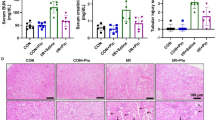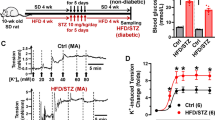Abstract
PKC-β inhibitor Ruboxistaurin (RBX or LY333531) can be used to reverse diabetic microvascular complication. However, it has not been previously established whether RBX can protect against ischemia/reperfusion (I/R) injury of cardiac microvessels in diabetic rats. STZ-induced diabetic rats were randomized into four groups and underwent I/R procedures. Cardiac barrier function and the region of cardiac microvascular lesion were examined. Cell monolayer barrier function was detected in cultured cardiac microvascular endothelial cells (CMECs) subjected to simulated I/R (SI/R). PKC-β siRNA was transfected into CMECs to silence PKC-β. Apoptosis Index of CMECs was detected by TUNEL assay and phosphor-LIMK2 protein expression was examined by Western blot analysis. RBX and insulin administration significantly reduced the cardiac microvascular lesion region and Apoptosis Index of endothelial cells (all P < 0.05 vs. no-treatment group). RBX decreased phosphor-LIMK2 expression (P < 0.05 vs. no-treatment group). RBX pretreatment and transfection with PKC-β siRNA induced a rapid barrier enhancement in CMECs monolayer as detected by increased transendothelial electrical resistance (TER) and decreased FITC-dextran clearance (all P < 0.05 vs. no-treatment group). Meanwhile, RBX pretreatment and transfection with PKC-β siRNA significantly decreased TUNEL positive CMECs and phosphor-LIMK2 expression in cultured CMECs (all P < 0.05 vs. no-treatment group). RBX pretreatment reduced F-actin/G-actin in cultured CMECs, reproducing the same effect as PKC-β siRNA. These data indicate that PKC-β inhibitor (RBX) may be helpful in attenuating the risk of severe cardiac microvascular I/R injury in diabetic rats partly due to its maintenance of endothelial barrier function and anti-apoptotic effect.






Similar content being viewed by others
References
Zhang Y, Galloway JM, Welty TK, Wiebers DO, Whisnant JP, Devereux RB et al (2008) Incidence and risk factors for stroke in american indians: the strong heart study. Circulation 118:1577–1584
Capes SE, Hunt D, Malmberg K, Gerstein HC (2000) Stress hyperglycaemia and increased risk of death after myocardial infarction in patients with and without diabetes: a systematic overview. Lancet 355:773–778
Di Filippo C, Marfella R, Cuzzocrea S, Piegari E, Petronella P, Giugliano D et al (2005) Hyperglycemia in streptozotocin-induced diabetic rat increases infarct size associated with low levels of myocardial HO-1 during ischemia/reperfusion. Diabetes 54:803–810
Paulson DJ (1997) The diabetic heart is more sensitive to ischemic injury. Cardiovasc Res 34:104–112
Kato M, Dote K, Sasaki S, Ueda K, Goto K, Takemoto H et al (2006) Plain computed tomography for assessment of early coronary microcirculatory damage after revascularization therapy in acute myocardial infarction. Circ J 70:1475–1480
Yuan SY, Ustinova EE, Wu MH, Tinsley JH, Xu W, Korompai FL et al (2000) Protein kinase C activation contributes to microvascular barrier dysfunction in the heart at early stages of diabetes. Circ Res 87:412–417
Scalia R, Gong Y, Berzins B, Zhao LJ, Sharma K (2007) Hyperglycemia is a major determinant of albumin permeability in diabetic microcirculation: the role of mu-calpain. Diabetes 56:1842–1849
Young ME, McNulty P, Taegtmeyer H (2002) Adaptation and maladaptation of the heart in diabetes: part II: potential mechanisms. Circulation 105:1861–1870
Scarabelli T, Stephanou A, Rayment N, Pasini E, Comini L, Curello S et al (2001) Apoptosis of endothelial cells precedes myocyte cell apoptosis in ischemia/reperfusion injury. Circulation 104:253–256
Das Evcimen N, King GL (2007) The role of protein kinase C activation and the vascular complications of diabetes. Pharmacol Res 55:498–510
Bazzoni G, Dejana E (2004) Endothelial cell-to-cell junctions: molecular organization and role in vascular homeostasis. Physiol Rev 84:869–901
Zeidan A, Javadov S, Karmazyn M (2006) Essential role of Rho/ROCK-dependent processes and actin dynamics in mediating leptin-induced hypertrophy in rat neonatal ventricular myocytes. Cardiovasc Res 72:101–111
Gutterman DD (2002) Vascular dysfunction in hyperglycemia: is protein kinase C the culprit? Circ Res 90:5–7
Budhiraja S, Singh J (2008) Protein kinase C beta inhibitors: a new therapeutic target for diabetic nephropathy and vascular complications. Fundam Clin Pharmacol 22:231–240
He Z, King GL (2004) Protein kinase Cbeta isoform inhibitors: a new treatment for diabetic cardiovascular diseases. Circulation 110:7–9
Beckman JA, Goldfine AB, Gordon MB, Garrett LA, Creager MA (2002) Inhibition of protein kinase Cbeta prevents impaired endothelium-dependent vasodilation caused by hyperglycemia in humans. Circ Res 90:107–111
Idris I, Donnelly R (2006) Protein kinase C beta inhibition: a novel therapeutic strategy for diabetic microangiopathy. Diab Vasc Dis Res 3:172–178
Ma H, Zhang HF, Yu L, Zhang QJ, Li J, Huo JH et al (2006) Vasculoprotective effect of insulin in the ischemic/reperfused canine heart: role of Akt-stimulated NO production. Cardiovasc Res 69:57–65
Xing W, Yan W, Fu F, Jin Y, Ji L, Liu W et al (2009) Insulin inhibits myocardial ischemia-induced apoptosis and alleviates chronic adverse changes in post-ischemic cardiac structure and function. Apoptosis 14:1050–1060
Raposo C, Zago GM, da Silva GH, da Cruz Hofling MA (2007) Acute blood-brain barrier permeabilization in rats after systemic Phoneutria nigriventer venom. Brain Res 1149:18–29
Reffelmann T, Hale SL, Dow JS, Kloner RA (2003) No-reflow phenomenon persists long-term after ischemia/reperfusion in the rat and predicts infarct expansion. Circulation 108:2911–2917
Chiang ET, Camp SM, Dudek SM, Brown ME, Usatyuk PV, Zaborina O et al (2009) Protective effects of high-molecular weight polyethylene glycol (PEG) in human lung endothelial cell barrier regulation: role of actin cytoskeletal rearrangement. Microvasc Res 77:174–186
Sun X, Shikata Y, Wang L, Ohmori K, Watanabe N, Wada J et al (2009) Enhanced interaction between focal adhesion and adherens junction proteins: involvement in sphingosine 1-phosphate-induced endothelial barrier enhancement. Microvasc Res 77:304–313
Harjai KJ, Stone GW, Boura J, Mattos L, Chandra H, Cox D et al (2003) Comparison of outcomes of diabetic and nondiabetic patients undergoing primary angioplasty for acute myocardial infarction. Am J Cardiol 91:1041–1045
Baldwin AL, Thurston G (2001) Mechanics of endothelial cell architecture and vascular permeability. Crit Rev Biomed Eng 29:247–278
Bazzoni G, Dejana E (2001) Pores in the sieve and channels in the wall: control of paracellular permeability by junctional proteins in endothelial cells. Microcirculation 8:143–152
Gao HK, Yin Z, Zhou N, Feng XY, Gao F, Wang HC (2008) Glycogen synthase kinase 3 inhibition protects the heart from acute ischemia-reperfusion injury via inhibition of inflammation and apoptosis. J Cardiovasc Pharmacol 52:286–292
Wang HC, Zhang HF, Guo WY, Su H, Zhang KR, Li QX et al (2006) Hypoxic postconditioning enhances the survival and inhibits apoptosis of cardiomyocytes following reoxygenation: role of peroxynitrite formation. Apoptosis 11:1453–1460
Yuan SY (2002) Protein kinase signaling in the modulation of microvascular permeability. Vascul Pharmacol 39:213–223
Yuan SY, Wu MH, Ustinova EE, Guo M, Tinsley JH, De Lanerolle P et al (2002) Myosin light chain phosphorylation in neutrophil-stimulated coronary microvascular leakage. Circ Res 90:1214–1221
Bernard O (2007) Lim kinases, regulators of actin dynamics. Int J Biochem Cell Biol 39:1071–1076
Vardouli L, Moustakas A, Stournaras C (2005) LIM-kinase 2 and cofilin phosphorylation mediate actin cytoskeleton reorganization induced by transforming growth factor-beta. J Biol Chem 280:11448–11457
van der Heijden M, Versteilen AM, Sipkema P, van Nieuw Amerongen GP, Musters RJ, Groeneveld AB (2008) Rho-kinase-dependent F-actin rearrangement is involved in the inhibition of PI3-kinase/Akt during ischemia-reperfusion-induced endothelial cell apoptosis. Apoptosis 13:404–412
Bao W, Hu E, Tao L, Boyce R, Mirabile R, Thudium DT et al (2004) Inhibition of Rho-kinase protects the heart against ischemia/reperfusion injury. Cardiovasc Res 61:548–558
Yada T, Shimokawa H, Hiramatsu O, Kajita T, Shigeto F, Tanaka E et al (2005) Beneficial effect of hydroxyfasudil, a specific rho-kinase inhibitor, on ischemia/reperfusion injury in canine coronary microcirculation in vivo. J Am Coll Cardiol 45:599–607
Acknowledgments
This study was supported by grants from the National Natural Science Foundation of China (NSFC, No. 30770784, 30970845) and Xijing Research Boosting Program (FC, NO. XJZT07Z05, XJZT08Z04).
Author information
Authors and Affiliations
Corresponding authors
Additional information
Liping Wei, Dongdong Sun and Zhiyong Yin contributed equally to this work.
Rights and permissions
About this article
Cite this article
Wei, L., Sun, D., Yin, Z. et al. A PKC-β inhibitor protects against cardiac microvascular ischemia reperfusion injury in diabetic rats. Apoptosis 15, 488–498 (2010). https://doi.org/10.1007/s10495-009-0439-2
Published:
Issue Date:
DOI: https://doi.org/10.1007/s10495-009-0439-2




